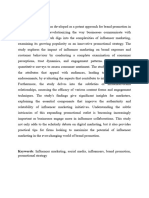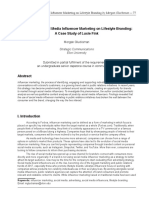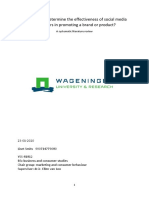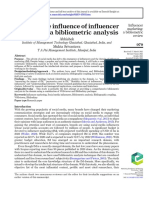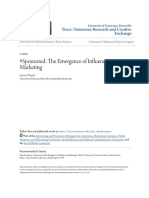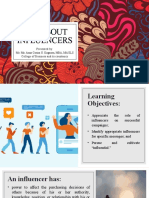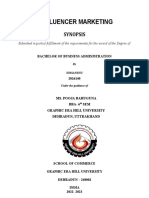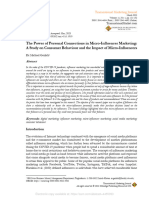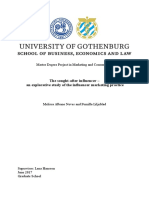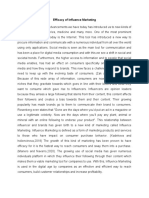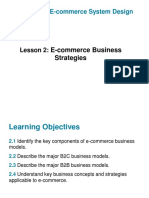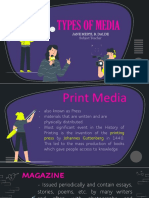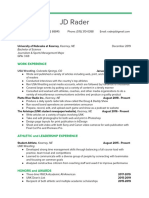2.
3 Empirical Literature Review
2.3.1 Social Media Influencers
Social media influencers are described as “individuals who have cultivated a significant and engaged
following across one or more social media platforms, possessing the capability to sway the views,
beliefs, and actions of their audience through their online content” (Freberg et al., p. 90). The term
“influencer” stems from the concept of “opinion leaders,” which was first introduced by Katz and
Lazarsfeld. These opinion leaders had the ability to impact others' preferences and behaviors through
their personal influence (Katz & Lazarsfeld, p. 15). As social media grew, the notion of opinion leaders
evolved, giving rise to “social media influencers” (Freberg et al., p. 90). Hudders et al. explain that
social media influencers, commonly known as “micro-celebrities,” play a crucial role in contemporary
marketing, gaining fame through their capability to endorse brands rather than through traditional
celebrity recognition. The professionalization of this sector has led to an increase in both influencers
and specialized marketing agencies. According to Hudders et al., two key traits of a social media
influencer are reach and impact. Reach refers to the influencer's direct and indirect connections to
their followers, whereas impact signifies their influence on the decision-making of their audience.
Influencers create this impact by showcasing expertise, authenticity, and intimacy, which enable
them to draw in larger audiences.
Social media influencers have developed from the early bloggers of the late 1990s, utilizing platforms
such as Instagram and YouTube to broaden their audience and diversify their content offerings. In
contrast to their predecessors, influencers reach larger groups of people, partner with brands, and
curate their online personas, building trust and significantly influencing consumer behavior through
their authenticity and relatability. The ever-changing landscape of influencer marketing calls for
widely accepted conceptual frameworks to facilitate consistent research and comparisons.
Researchers are challenged by the rapidly evolving nature of social media platforms, their features,
and marketing tactics. Much of the existing research is concentrated on Western contexts,
highlighting the need to explore how culture and context affect the effectiveness of social media
influencers (Hudders et al.). Growing consumer skepticism towards sponsored content weakens the
impact of social media influencers and complicates the identification of appropriate influencers and
the evaluation of their performance metrics. A bibliometric study by Ye et al. noted that while
previous research has emphasized the traits of social media influencers, there is also potential to
investigate the characteristics of the content they produce. This meta-analysis intends to bring
together the factors that influence social media influencer effectiveness, separate the effects of
cultural and contextual elements, and ultimately aid in informed managerial decision-making and
theoretical progress.
2.3.2 How Influencer Marketing Developed/Evolved
Historically, individuals have often been influenced by the views of others, particularly prominent
figures such as religious leaders or affluent people, due to the belief that they have greater
knowledge (Johansen and Guldvik, 2017). In addition, in the past, people had limited access to
information that would enable them to make informed choices. This scarcity of information led
individuals to rely on the perspectives of others, whom they regarded as sources of information for
their purchasing decisions. However, technological advancements have changed the way information
is consumed and understood, granting individuals access to a wide array of brands and products.
Personal blogs created for sharing information have quickly emerged as a credible marketing
resource (Mohit, 2011). Word of mouth (WOM) marketing evolved concurrently with the rise of
social media, as individuals sought to share their reviews and opinions about their purchases, and
�others were eager to read these messages (Johansen and Guldvik, 2017). Consequently, influencer
marketing is a natural extension of people's inherent inclination to disseminate information about
products and to seek out the reviews and opinions of others.
Initially, influencers predominantly relied on text-based content shared through blogs. According to
the Association of National Advertisers (2018), in 2013, 86% of influencer content was produced in
the form of blog articles. While blogs remain a legitimate platform for content creation by
influencers, the use of images and videos has become significantly more prevalent lately. The visual
aspect has turned into a crucial component of this marketing approach. Mohit (2011) offers a
framework to explain how the visual attributes of an influencer's page correlate with improved brand
perceptions. The advancement of technology and the rising popularity of social media platforms
have supported the growth of the influencer marketing sector, enabling everyday individuals and
consumers to influence the choices of millions (Johansen and Guldvik, 2017). Despite its widespread
use, there is a lack of substantial evidence supporting the theory of influencer marketing.
2.3.3 Types of Influencers
Social media influencers are divided into five categories based on their number of followers: nano
(1–5K), micro (5–20K), mid-tier (20–100K), mega (100K–1M), and celebrities (more than 1M)
(HypeAuditor, 2021). The largest group consists of micro influencers at 47.3%, followed by mid-tier
influencers at 26.8% and nano influencers at 18.74%, while macro, mega, and celebrity influencers
make up just a small fraction (0.5% combined). Interestingly, nano influencers enjoy the highest
engagement rates at 5%, which significantly decreases to 1.6% for celebrities (HypeAuditor, 2021).
The impact of social media influencers on consumer attitudes and behaviors differs greatly based on
variations in reach, engagement, and perceived authenticity. Although they have fewer followers,
nano influencers build more personal and frequent connections with their audience, leading to
greater engagement. The way they are seen as more authentic, relatable, and trustworthy (Abidin,
2018) leads to their endorsements being perceived as sincere recommendations (Brown & Phifer,
2018), making their promotions especially beneficial for specialized or localized products and
services.
The impact of prominent personalities like NanaAma McBrown, who have significant followings,
arises from their wide-reaching engagement, fame, quality content, partnerships with well-known
brands, and ability to set trends (De Veirman et al., 2017). Their visibility sparks interest in products,
and their endorsements quickly increase exposure. The appeal of the products is amplified by the
expertly created content, while their association with reputable companies enhances credibility.


